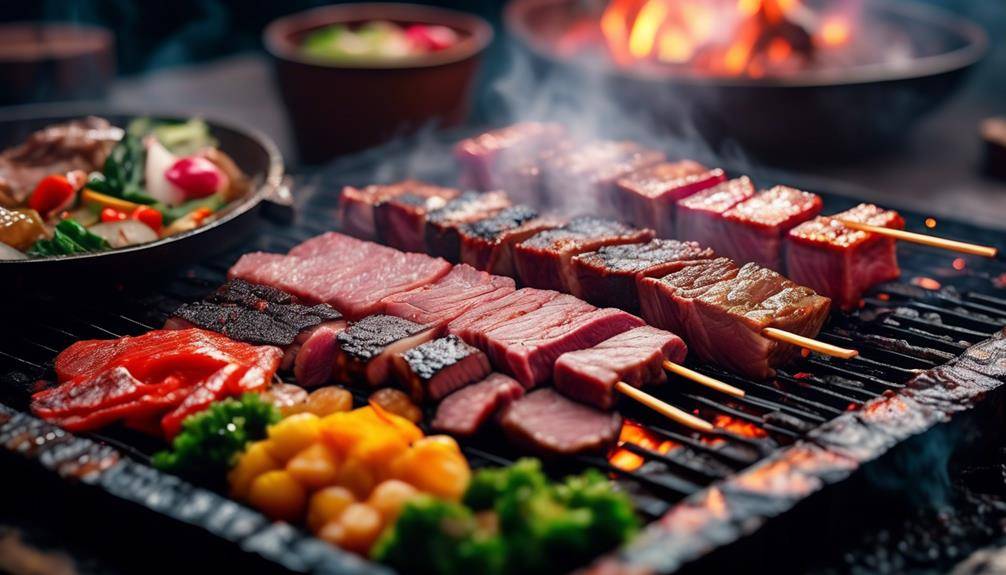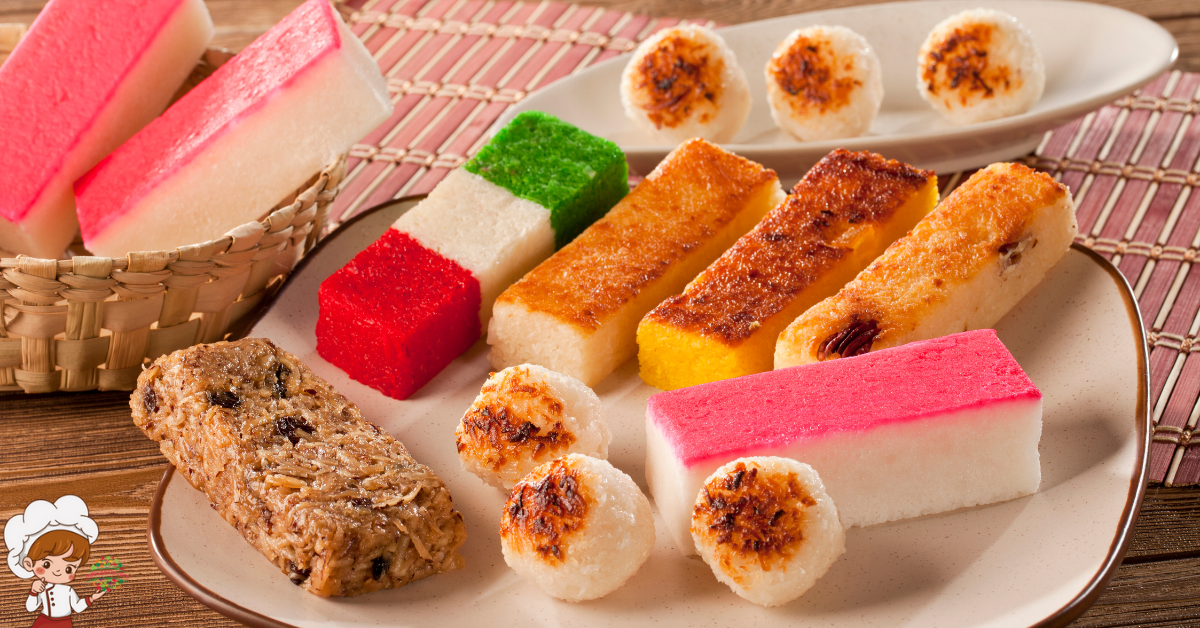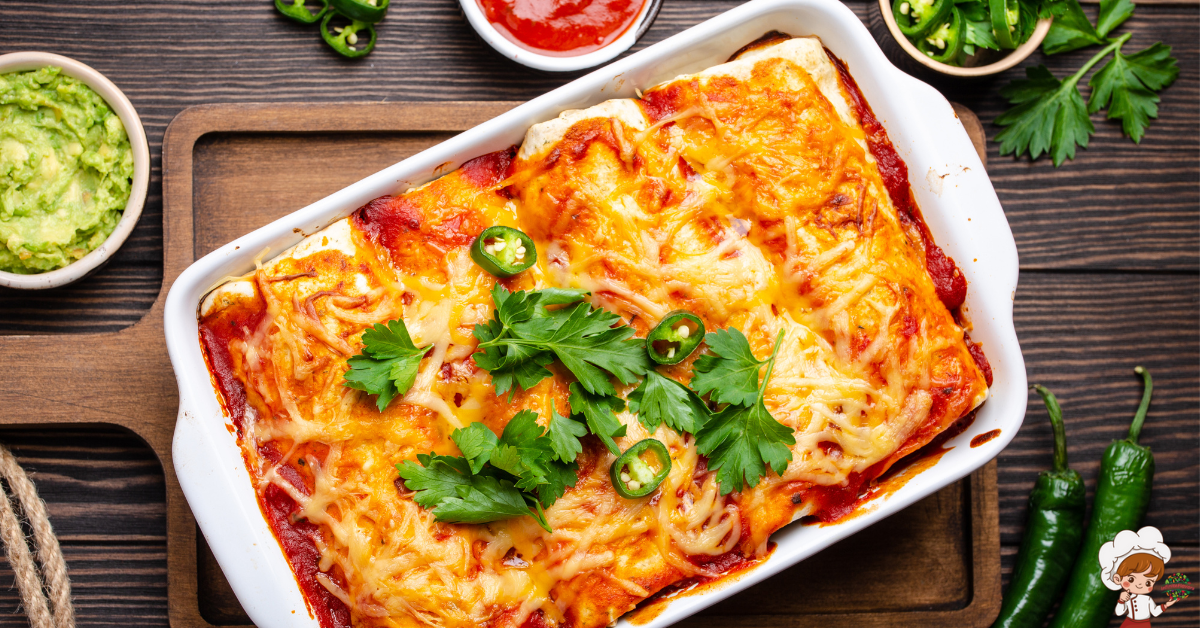Unique Japanese Yakiniku Barbecue Experience

Unique Japanese Yakiniku Barbecue Experience; Step into a realm where sizzling meats dance on the grill, their tantalizing aromas wafting through the air like a symphony of flavors. At the unique Japanese Yakiniku Barbecue, you will embark on a culinary journey like no other. But what sets this experience apart? What secrets lie behind the art of grilling meat to perfection? From the history of Yakiniku in Japan to the different types of grills and mouthwatering regional specialties, this discussion will uncover the intricacies of this extraordinary barbecue tradition. So, prepare to be captivated by the secrets of Yakiniku and discover a world where every bite is a delectable revelation.
History of Yakiniku in Japan
Yakiniku, a beloved Japanese culinary tradition, has a rich and fascinating history that will transport you to a time when sizzling meats and tantalizing aromas filled the air of bustling Japanese streets. But did you know that yakiniku actually originated in Korea? Yes, the history of yakiniku in Japan can be traced back to the Korean immigrants who settled in the country during the early 20th century.
When the Korean immigrants brought their grilling techniques to Japan, they introduced a new way of cooking meat that would soon become a sensation. Yakiniku, which means “grilled meat” in Japanese, quickly gained popularity among the locals, who were captivated by the unique flavors and interactive dining experience it offered.
Over time, yakiniku evolved and developed its own distinct style in Japan. The Japanese took the Korean concept and adapted it to fit their culinary preferences, incorporating local ingredients and seasonings. This fusion of Korean and Japanese flavors resulted in a truly exceptional dining experience that continues to be loved by people all over the world.
Today, the influence of yakiniku on international cuisine is undeniable. Yakiniku restaurants can be found in many countries, offering diners a chance to indulge in the deliciousness of grilled meat. The interactive nature of yakiniku, where you cook your own meat at the table, has also inspired other forms of tabletop grilling, such as Korean barbecue and Mongolian barbecue.
Different Types of Yakiniku Grills
Now let’s explore the fascinating world of different types of Yakiniku grills. From tabletop grills to traditional charcoal ones, there is a wide variety to choose from. Each grill offers a unique heating mechanism, whether it be electric, gas, or charcoal, that adds its own distinct flavor and cooking experience to your Yakiniku feast. So, get ready to savor mouthwatering grilled meats as we dive into the world of Yakiniku grills.
Grill Varieties
When it comes to the world of yakiniku barbecue, there is a wide array of grill varieties that will take your culinary experience to the next level. From traditional charcoal grills to modern electric grills, each type offers its own unique cooking experience. One popular option is the hibachi grill, known for its compact size and portability. It allows for precise control of heat, making it ideal for yakiniku cooking techniques like searing and grilling.
Another option is the teppanyaki grill, which features a flat cooking surface perfect for cooking thinly sliced meats and vegetables. Lastly, the gas grill provides convenience with its quick heating and easy grill maintenance. No matter which grill variety you choose, you can be sure to enjoy the authentic flavors of yakiniku in the comfort of your own home.
Heating Mechanisms
To truly understand the different types of yakiniku grills, it is essential to delve into their unique heating mechanisms. Yakiniku grills are known for their versatility and ability to cook meat to perfection. One of the most common heating mechanisms used in yakiniku grills is the charcoal grill. The smoky flavor that the charcoal imparts on the meat is what makes yakiniku so distinctive.
Another popular option is the gas grill, which provides a convenient and efficient way to cook yakiniku. Some yakiniku restaurants even use electric grills, which offer precise temperature control for a consistent cooking experience. No matter which type of grill you choose, mastering the art of yakiniku requires knowledge of different grilling techniques and the ability to control the heat. For an authentic yakiniku experience, I recommend trying out popular yakiniku restaurants like Gyukatsu Motomura in Tokyo or Yakiniku Jumbo Hanare in Osaka.
Choosing the Right Cuts of Meat
When it comes to choosing the right cuts of meat for your yakiniku barbecue experience, you want to aim for the best meat cuts that will give you a burst of flavor with every bite. Look for options such as marbled Wagyu beef, which is known for its rich and buttery taste, or tender cuts like ribeye and short ribs. These flavorful meat options are sure to elevate your yakiniku experience to a whole new level.
Best Meat Cuts
For the ultimate Japanese yakiniku barbecue experience, selecting the best meat cuts is crucial to ensure a mouthwatering and satisfying meal. When it comes to yakiniku, the quality and cut of the meat are of utmost importance. The best cuts for yakiniku are those with a good balance of marbling and tenderness. The most popular choice is wagyu beef, known for its rich flavor and melt-in-your-mouth texture.
Other popular cuts include ribeye, sirloin, and short ribs. To enhance the natural flavors of the meat, the best seasoning options for yakiniku include soy sauce, garlic, and sesame oil. When it comes to grilling techniques, it’s important to cook the meat quickly over high heat to seal in the juices and achieve a delicious charred exterior. Remember, choosing the right meat cuts and mastering the grilling techniques will elevate your yakiniku experience to new heights.
Flavorful Meat Options
Looking to elevate your Japanese yakiniku barbecue experience? Let’s explore the flavorful meat options and discover the perfect cuts to tantalize your taste buds. When it comes to yakiniku, the key is to choose cuts of meat that can absorb and enhance the flavors of the marinades and grilling techniques. Here are five delicious options to consider:
- Wagyu Beef: Known for its rich marbling and melt-in-your-mouth texture, Wagyu beef is a top choice for yakiniku. Its high fat content creates an intense flavor experience.
- Pork Belly: With its juicy and tender meat, pork belly is a popular choice for grilling. Its layers of fat make it incredibly flavorful when cooked over an open flame.
- Chicken Thighs: Chicken thighs are perfect for those who prefer leaner meat. Marinating them in flavorful sauces adds a burst of taste to every bite.
- Short Ribs: These meaty and succulent ribs are a classic yakiniku choice. Their marbling and tender texture make them ideal for grilling.
- Lamb Chops: If you’re looking to add a unique twist to your yakiniku, lamb chops are a great option. Their robust flavor pairs perfectly with flavorful marinades.
Marinating and Seasoning Techniques
Enhance the flavor of your yakiniku barbecue by mastering the art of marinating and seasoning techniques. Marinating is a crucial step in preparing the meat for the grill. It not only tenderizes the meat but also infuses it with delightful flavors. There are various marinating techniques that you can explore to create mouthwatering yakiniku dishes.
One popular method is using a soy-based marinade. Soy sauce adds a savory umami flavor to the meat while also tenderizing it. Combine soy sauce with ingredients like garlic, ginger, and sesame oil to create a rich and aromatic marinade. For a sweeter twist, you can add honey or sugar to balance out the saltiness of the soy sauce.
Another flavoring method is to use fruit-based marinades. Pineapple juice, for example, contains enzymes that break down proteins and make the meat more tender. You can combine it with soy sauce, ginger, and brown sugar to create a tangy and sweet marinade. The natural sweetness of the pineapple will complement the smoky flavors of the barbecue.
If you prefer a spicy kick, consider using chili-based marinades. Mix together chili paste, garlic, soy sauce, and a touch of honey for a fiery marinade. The heat from the chili will add depth and complexity to the meat, making each bite a flavorful adventure.
Remember to marinate the meat for at least a few hours or, ideally, overnight to allow the flavors to penetrate the meat fully. Once marinated, you can grill the meat to perfection and savor the incredible taste you have created.
With these marinating techniques and flavoring methods, you can elevate your yakiniku barbecue experience to new heights. Experiment with different combinations of ingredients to find your favorite flavors and create a truly unique dining experience. So, fire up the grill and get ready to impress your guests with your mastery of marinating and seasoning techniques.
Vegetarian Options for Yakiniku
Looking for vegetarian options for your yakiniku experience? No worries! There are plenty of delicious choices to satisfy your cravings. From veggie meat alternatives that mimic the texture and taste of meat, to perfectly grilled tofu options that are bursting with flavor, you won’t feel like you’re missing out. And let’s not forget about the delightful seasonal vegetable skewers, showcasing the vibrant colors and natural sweetness of fresh produce. Get ready to indulge in a vegetarian yakiniku feast like no other!
Veggie Meat Alternatives
For those seeking a vegetarian twist on the traditional yakiniku experience, there are a plethora of veggie meat alternatives available to satisfy your cravings. Whether you follow a plant-based diet or simply want to switch things up, these vegetarian protein sources make for a delicious and guilt-free yakiniku feast. Here are five veggie meat alternatives that will surely tantalize your taste buds:
- Tofu: This versatile soy-based product can be marinated and grilled to perfection, taking on the flavors of your favorite yakiniku sauce.
- Seitan: Made from wheat gluten, seitan has a chewy texture and absorbs marinades beautifully, making it an ideal choice for yakiniku.
- Mushrooms: Portobello or shiitake mushrooms are excellent options, offering a meaty texture and earthy flavor that pairs well with yakiniku.
- Tempeh: This fermented soybean product has a nutty taste and firm texture, making it a great substitute for meat in yakiniku dishes.
- Vegetable skewers: Load up your skewers with colorful vegetables like bell peppers, zucchini, and eggplant for a vibrant and healthy yakiniku experience.
With these veggie meat alternatives, you can enjoy all the flavors and excitement of yakiniku while staying true to your vegetarian or plant-based lifestyle.
Grilled Tofu Options
If you’re craving a vegetarian twist on the traditional yakiniku experience, look no further than the delectable grilled tofu options available to satisfy your taste buds. While yakiniku is typically known for its succulent grilled meats, many yakiniku restaurants now offer a variety of vegetarian alternatives, and tofu takes center stage as a flavorful and versatile option. With its tender texture and ability to absorb flavors, tofu becomes a perfect canvas for the smoky and savory yakiniku marinades.
Whether you prefer it grilled to perfection with a caramelized exterior or simmered in a rich and aromatic sauce, there are plenty of grilled tofu options to explore. From marinated tofu skewers to tofu steaks served with dipping sauces, these vegetarian yakiniku alternatives are sure to impress even the most discerning palates.
Seasonal Vegetable Skewers
Now that we’ve explored the delicious grilled tofu options for yakiniku, let’s turn our attention to the vibrant and flavorful world of seasonal vegetable skewers, providing even more vegetarian options to enhance your yakiniku experience.
- Grilled Vegetable Options:
- Juicy cherry tomatoes bursting with flavor, perfectly charred on the outside.
- Crispy zucchini slices, lightly seasoned with salt and pepper, adding a delightful crunch to each bite.
- Tender asparagus spears, grilled to perfection and topped with a drizzle of tangy balsamic glaze.
- Sweet bell peppers, vibrant in color and smoky in taste, creating a beautiful contrast on your plate.
- Earthy mushrooms, such as shiitake or portobello, absorbing the smoky aroma of the grill.
And if you’re looking for a touch of sweetness, why not try some seasonal fruit skewers? Grilled pineapple, with its caramelized edges, provides a tropical twist to your yakiniku feast. Or perhaps you’d prefer grilled peaches, their natural sugars intensifying as they cook, creating a luscious and juicy treat. These fruit skewers offer a refreshing and delightful way to balance out the savory flavors of your yakiniku meal.
Sides and Accompaniments for Yakiniku
Enhance your yakiniku experience with a selection of delectable sides and accompaniments that perfectly complement the rich flavors of the grilled meats. Grilled seafood options are a unique addition to any yakiniku meal, offering a delightful contrast to the savory meats. One popular choice is the grilled squid, which is tender and slightly charred, with a hint of smokiness that adds depth to each bite. The squid is often marinated in a soy-based sauce, enhancing its natural sweetness and adding a touch of umami.
Another seafood option is grilled shrimp, which is succulent and juicy, with a slightly charred exterior that gives it a delightful crunch. The shrimp can be seasoned with a variety of spices and herbs, such as garlic, ginger, and chili, to add a burst of flavor.
In addition to grilled seafood, there are also unique yakiniku accompaniments that elevate the overall dining experience. One such accompaniment is kimchi, a traditional Korean side dish made from fermented vegetables. The tangy and spicy flavors of kimchi help to cleanse the palate between bites of rich, grilled meats. Another popular accompaniment is goma sauce, a creamy sesame-based dipping sauce that adds a nutty and slightly sweet flavor to the grilled meats. The sauce is made by grinding toasted sesame seeds and combining them with soy sauce, sugar, and other seasonings. It provides a delicious contrast to the smoky flavors of the grilled meats.
To complete your yakiniku feast, don’t forget to indulge in some steamed rice, which serves as the perfect base for all the various flavors and textures of the meal. The soft and fluffy rice helps to balance out the richness of the grilled meats and seafood, allowing you to fully savor each bite. Additionally, a refreshing salad is a great way to add some freshness and crunch to the meal. A simple salad of mixed greens, thinly sliced cucumbers, and cherry tomatoes dressed with a light vinaigrette is the perfect accompaniment to the robust flavors of yakiniku.
With the addition of these sides and accompaniments, your yakiniku experience will be elevated to new heights. The combination of grilled seafood, unique accompaniments, steamed rice, and a refreshing salad will create a symphony of flavors that will leave you craving more. So, fire up the grill, gather your friends and family, and get ready to embark on a truly unique and unforgettable yakiniku adventure.
Etiquette and Customs at a Yakiniku Barbecue
As you prepare to indulge in the delectable flavors of yakiniku, it is important to familiarize yourself with the proper etiquette and customs that accompany this unique barbecue experience. Yakiniku barbecue table manners play a significant role in Japanese culture, and adhering to them will ensure a seamless and enjoyable dining experience. Here are some key points to keep in mind:
- Grilling Order: In a communal yakiniku setting, it is customary to take turns grilling the meat. The person sitting closest to the grill usually takes charge and rotates the meat, ensuring that everyone gets a fair share of the deliciousness.
- Sharing is Caring: Yakiniku is a social affair, so it’s customary to share your grilled meat with others at the table. You can use chopsticks or tongs to transfer the meat onto individual plates or communal platters.
- Dipping Sauce: Yakiniku is often enjoyed with a variety of dipping sauces. One common practice is to dip the grilled meat into the sauce before eating it. However, be mindful not to double-dip, as it is considered impolite.
- Traditional Yakiniku Utensils: When dining at a yakiniku restaurant, you will typically be provided with a set of traditional utensils. These may include long metal chopsticks for grilling the meat, tongs for flipping and transferring, and a small grill brush for cleaning the grill.
- Respecting the Chef: Yakiniku chefs possess a wealth of knowledge and skill when it comes to grilling the perfect meat. Show your appreciation by allowing them to guide you through the experience. Trust their expertise and follow their instructions on how to cook the meat to perfection.
Popular Yakiniku Sauces and Dips
When it comes to yakiniku, the perfect complement to the grilled meat is a selection of popular sauces and dips that add an extra layer of flavor and excitement to your dining experience. Japanese yakiniku is known for its variety of delicious dipping sauces that enhance the taste of the succulent grilled meats. There are several popular yakiniku sauce brands that offer unique flavors and textures to suit every palate.
One of the most well-known yakiniku sauce brands is Bull-Dog, which has been a favorite among yakiniku enthusiasts for decades. Their rich and savory sauce is made with a blend of soy sauce, fruit puree, and spices, giving it a distinct umami flavor. The Bull-Dog sauce is versatile and can be used as a marinade or as a dipping sauce for grilled meats.
Another popular brand is Yakiniku no Tare, which offers a range of dipping sauces with different flavors and levels of spiciness. Their unique yakiniku dipping sauces include garlic soy sauce, spicy miso, and sesame sauce. Each sauce is carefully crafted to bring out the natural flavors of the grilled meat, creating a harmonious balance of taste.
For those looking for a more adventurous flavor, there are also specialty yakiniku dipping sauces available. These include wasabi-infused sauces, citrus-based sauces, and even sake-based sauces. These unique sauces add an unexpected twist to the traditional yakiniku experience, elevating it to a whole new level.
Pairing Drinks With Yakiniku
To truly elevate your yakiniku experience, you’ll want to pair your grilled meats with the perfect drinks. The right beverage can complement the rich flavors of the barbecue, enhancing your enjoyment of each bite. Whether you prefer alcoholic cocktails or non-alcoholic options, there are plenty of choices to suit your taste. Here are five drink pairings that will take your yakiniku experience to the next level:
- Sake: A classic choice, sake is a traditional Japanese rice wine that pairs well with the smoky, savory flavors of yakiniku. Its clean, crisp taste cleanses the palate between bites, allowing you to fully appreciate the complexity of the grilled meats.
- Japanese Whisky: For those who prefer a stronger drink, Japanese whisky is an excellent choice. Its smooth, slightly peaty flavor complements the bold flavors of yakiniku, adding a touch of sophistication to your meal.
- Yuzu Sour: If you’re in the mood for a refreshing cocktail, try a yuzu sour. Made with fresh yuzu juice, this tangy drink balances the richness of the grilled meats, creating a harmonious blend of flavors.
- Ginger Ale: For a non-alcoholic option, ginger ale is a great choice. Its spicy, effervescent taste pairs well with the smoky flavors of yakiniku, providing a refreshing contrast to the grilled meats.
- Green Tea: Another non-alcoholic option, green tea is a classic pairing for yakiniku. Its clean, earthy flavor complements the grilled meats, cleansing the palate and preparing you for the next bite.
Yakiniku Specialties From Different Regions of Japan
Discover the diverse and mouthwatering yakiniku specialties from different regions of Japan. Each region has its own unique yakiniku sauce variations and special marinades that make their barbecue experience truly one-of-a-kind.
In Osaka, the birthplace of yakiniku, you’ll find a variety of savory and sweet sauces to accompany your grilled meats. The most famous is the sweet and tangy “tare” sauce, made with soy sauce, mirin, garlic, and ginger. This sauce is perfect for marinating and dipping your meats, creating a delicious caramelized coating.
Head to Hiroshima, and you’ll be treated to their signature “Hiroshima-style yakiniku.” Here, they use a special marinade made with local ingredients like Hiroshima-style okonomiyaki sauce and oyster sauce. The result is a rich, umami flavor that perfectly complements the smoky taste of the grilled meats.
In Hokkaido, known for its fresh seafood and rich dairy products, you can enjoy unique yakiniku marinades that incorporate these local flavors. Try their miso-based marinade, which adds a rich and savory taste to your grilled meats. Or opt for their butter-based marinade, which adds a creamy and indulgent touch to your yakiniku experience.
Venture to Kyushu, and you’ll discover the spicy side of yakiniku. Here, they love to add a kick to their marinades with ingredients like chili peppers, garlic, and ginger. The result is a fiery and flavorful barbecue experience that will leave your taste buds tingling.
No matter which region you visit, you’re sure to find a yakiniku specialty that will tantalize your taste buds. From sweet and tangy sauces to unique marinades, each region offers a unique twist on this beloved Japanese barbecue tradition. So, get ready to embark on a culinary adventure and savor the diverse flavors of yakiniku across Japan.
Tips for Cooking Meat to Perfection
Now that you have learned about the diverse and mouthwatering yakiniku specialties from different regions of Japan, let’s dive into some essential tips for cooking your meat to perfection. When it comes to yakiniku, the cooking techniques and meat selection are crucial in achieving that delicious, tender, and flavorful result. Here are five tips to help you elevate your yakiniku cooking game:
- Choose the right cut: Selecting the right cut of meat is essential for a successful yakiniku experience. Opt for well-marbled cuts like ribeye, short ribs, or wagyu beef, as they tend to be more tender and flavorful when grilled.
- Prep and marinate: Before grilling your meat, it’s important to properly prep and marinate it. Tenderize the meat by lightly pounding it and then marinate it in a flavorful sauce or marinade to enhance its taste. Let it marinate for at least 30 minutes, or even overnight, for optimal flavor.
- Master the grill temperature: Controlling the grill temperature is key to cooking your meat to perfection. Start by preheating the grill to medium-high heat and then adjust the temperature as needed. This will ensure that your meat cooks evenly and retains its juiciness.
- Don’t overcrowd the grill: When grilling yakiniku, it’s important not to overcrowd the grill. Give each piece of meat enough space to cook properly without touching each other. This allows for better heat circulation and ensures that the meat cooks evenly.
- Monitor the cooking time: Keep a close eye on the cooking time to avoid overcooking or undercooking your meat. Different cuts and thicknesses require different cooking times, so it’s important to monitor the meat closely and flip it at the right moment to achieve that perfect doneness.
Yakiniku Desserts and Sweet Treats
Get ready to satisfy your sweet tooth with a delectable array of yakiniku desserts and sweet treats that will perfectly complement your barbecue experience. Just like the savory delights of yakiniku, the world of yakiniku inspired desserts is full of creativity and unique flavors. Whether you’re looking for a refreshing end to your meal or a decadent indulgence, these creative yakiniku dessert ideas will surely leave you wanting more.
One popular yakiniku dessert is the Grilled Fruit Skewers. Imagine skewers of juicy pineapple, ripe bananas, and sweet strawberries, grilled to perfection and served with a drizzle of honey. The caramelization from the grill adds a smoky richness to the natural sweetness of the fruits, creating a delightful combination of flavors.
For a twist on traditional Japanese desserts, try the Yakiniku S’mores. Instead of the usual graham crackers, use crispy rice crackers or senbei as the base. Top it with a piece of dark chocolate and a perfectly toasted marshmallow. The combination of the smoky marshmallow and the rich chocolate will transport you to a campfire, adding a playful and nostalgic touch to your yakiniku experience.
If you’re in the mood for something more indulgent, the Yakiniku Ice Cream Sundae is the perfect choice. Start with a scoop of creamy vanilla ice cream, then top it with grilled banana slices, a drizzle of caramel sauce, and a sprinkle of roasted peanuts. The contrast between the warm, caramelized bananas and the cold, velvety ice cream creates a delightful explosion of flavors and textures.
These yakiniku inspired desserts offer a unique and delicious way to end your barbecue experience. So don’t forget to save some room for these sweet treats and elevate your yakiniku adventure to a whole new level.
Yakiniku Barbecue at Home: DIY Tips and Recipes
If you’re eager to recreate the authentic yakiniku barbecue experience in the comfort of your own home, we’ve got you covered with some expert DIY tips and mouthwatering recipes. With the right yakiniku barbecue equipment and grilling techniques, you can enjoy the smoky flavors and tender textures of this Japanese culinary delight. Here are some tips to help you get started:
- Get the right equipment: Invest in a tabletop charcoal grill or an electric grill with a smokeless feature. These are perfect for yakiniku as they allow for precise temperature control and even heat distribution.
- Choose the right cuts of meat: Look for well-marbled cuts like ribeye, short ribs, and skirt steak. These cuts are flavorful and tender, perfect for grilling.
- Marinate your meat: To infuse your meat with delicious flavors, marinate it in a mixture of soy sauce, garlic, ginger, and sesame oil. Let it sit for at least 30 minutes to overnight for maximum flavor.
- Master the grilling techniques: Preheat your grill to high heat and grill the meat in small batches. Cook it quickly, turning frequently to achieve a nice sear and juicy interior.
- Serve with dipping sauces: Yakiniku is traditionally served with a variety of dipping sauces. Try making your own by combining soy sauce, sesame oil, rice vinegar, and chili paste. Experiment with different flavors to find your favorite combination.
With these DIY tips and recipes, you can create a yakiniku barbecue experience that rivals your favorite Japanese restaurant. So fire up the grill, gather your friends and family, and get ready to enjoy the delicious flavors of yakiniku in the comfort of your own home.
Japanese Yakiniku Barbecue; Frequently Asked Questions
Are There Any Vegetarian Options Available at a Yakiniku Barbecue?
You’ll be happy to know that there are indeed vegetarian options available at a yakiniku barbecue! You can incorporate vegetarian ingredients like tofu, mushrooms, and veggies into your yakiniku cooking for a delicious and satisfying meal.
What Are Some Popular Yakiniku Sauces and Dips?
When it comes to yakiniku barbecue, there are a variety of popular sauce flavors to enhance your experience. From tangy soy garlic to spicy miso, these unique dipping sauces add an extra layer of deliciousness to your grilled meats.
What Are Some Tips for Cooking Meat to Perfection on a Yakiniku Grill?
To cook meat to perfection on a yakiniku grill, try these tips: marinate for flavor, slice thin for quick cooking, and sear on high heat. For the best cuts, go for tender cuts like ribeye or wagyu beef.
Can You Provide Some Yakiniku Specialties From Different Regions of Japan?
When it comes to yakiniku specialties from different regions of Japan, you’re in for a treat! From Kobe beef in Hyogo to the renowned Matsusaka beef in Mie, each region offers its unique and delectable flavors. Get ready to indulge!
What Are Some DIY Tips and Recipes for Yakiniku Barbecue at Home?
To create an authentic yakiniku barbecue experience at home, try out different yakiniku marinades and experiment with grilling techniques. From savory soy-based marinades to tangy citrus flavors, you’ll be able to recreate the unique Japanese yakiniku experience in your own backyard.
Conclusion
In conclusion, the unique Japanese yakiniku barbecue experience offers a fascinating journey into the history, techniques, and specialties of this beloved cuisine. From choosing the perfect cuts of meat to mastering the art of marinating and seasoning, yakiniku allows you to create delicious and mouthwatering dishes. Whether you’re a vegetarian or a meat lover, there are options for everyone to enjoy. So fire up your grill, explore different regional specialties, and indulge in the delightful world of yakiniku barbecue.








